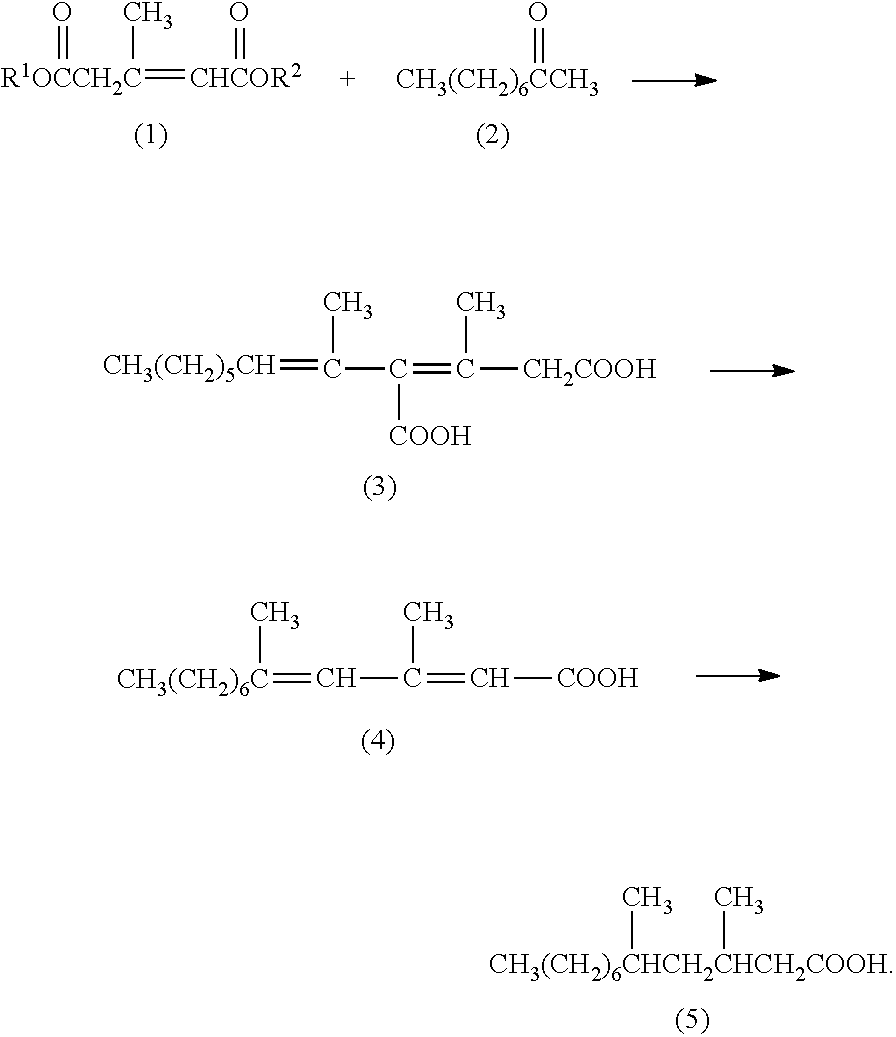Method for producing 3,5-dimethyldodecanoic acid; and 4-carboxy-3,5-dimethyl-3,5-dodecadienoic acid
a technology of 3,5-dimethyldodecanoic acid and 3,5-dimethyldodecanoic acid, which is applied in the preparation of carboxylic compounds, fatty acid chemical modifications, organic chemistry, etc., can solve the problems of difficult to industrially produce a sufficient amount of 3,5-dimethyldodecanoic acid, the method is far from an industrial synthesis method, and the number of steps is reduced. , to achieve the effect of efficient production and reduced
- Summary
- Abstract
- Description
- Claims
- Application Information
AI Technical Summary
Benefits of technology
Problems solved by technology
Method used
Image
Examples
synthesis example 1
Synthesis of 3-methyl-2-pentene-1,5-diacid dimethyl
[0075]3-Methyl-2-pentene-1,5-diacid dimethyl which is Compound (1) having CH3 as R1 and R2 will also be described as “Compound (1dMe)”.
[0076]In a nitrogen atmosphere, 1.04 g of a 28% by weight solution of sodium methoxide in methanol was added dropwise in 5 minutes to a mixture of 9.01 g of methyl 2-oxo-4,6-dimethyl-2H-pyran-5-carboxylate with purity of 99.1% and 8 g of methanol while stirring at room temperature. The purity was based on GC analysis herein and below. The reaction mixture was stirred for one hour under refluxing with heating. After the reaction mixture was concentrated under reduced pressure, distillation under reduced pressure resulted in 5.22 g (91.0% purity) of an intended product A yield calculated from the sum of each fraction weight multiplied by purity thereof with respect to all fractions was 76.5%.
example 1
Synthesis of Unsaturated Dicarboxylic Acid Isomer Mixture Containing 4-carboxy-3,5-dimethyl-3,5-dodecadienoic Acid (3)
[0077](Example in which Sodium Methoxide was Used as a Base)
[0078]In a nitrogen atmosphere, 300.39 g of a 28% by weight solution of sodium methoxide in methanol was added dropwise in 40 minutes to a mixture of 89.36 g of 3-methyl-2-pentene-1,5-diacid dimethyl (1dMe) with purity of 90.1%, 82.19 g of 2-nonanone (2) with purity of 98.8% and 90 g of methanol while stirring at room temperature. The reaction mixture was stirred at 65° C. for 3 hours. While stirring the reaction mixture at 65° C., 249.12 g of a 25% by weight aqueous sodium hydroxide solution and 93.42 g of water were added dropwise thereto in 15 minutes. The reaction mixture was stirred for 6 hours at 65° C. The reaction mixture was cooled to room temperature and then extracted twice with 400 ml of n-hexane to separate an aqueous phase from an organic phase. The aqueous phase was subjected to addition of 65...
example 2
Synthesis of 3,5-dimethyl-2,4-dodecadienoic Acid (4)
[0088](Example in which Decarboxylation was Carried Out Using Tributylamine as a Base)
[0089]In a nitrogen atmosphere, a mixture of 15.33 g of an unsaturated dicarboxylic acid isomer mixture containing 4-carboxy-3,5-dimethyl-3,5-dodecadienoic acid (3) and 1.58 g of tributylamine was stirred at 140° C. for 5 hours. The reaction mixture was cooled to 70° C. and 13.20 g of a 28% by weight solution of sodium methoxide in methanol was added dropwise thereto in 5 minutes while stirring at 70° C. The reaction mixture was stirred at 70° C. for 3 hours. While the reaction mixture was stirred at 70° C., 27.36 g of a 25% by weight aqueous sodium hydroxide solution and 30.00 g of water were added dropwise thereto in 5 minutes. The reaction mixture was stirred at 70° C. for 6 hours. The reaction mixture was cooled to room temperature and extracted twice with 20 ml of n-hexane to separate an aqueous phase from an organic phase. The aqueous phase ...
PUM
 Login to View More
Login to View More Abstract
Description
Claims
Application Information
 Login to View More
Login to View More - R&D
- Intellectual Property
- Life Sciences
- Materials
- Tech Scout
- Unparalleled Data Quality
- Higher Quality Content
- 60% Fewer Hallucinations
Browse by: Latest US Patents, China's latest patents, Technical Efficacy Thesaurus, Application Domain, Technology Topic, Popular Technical Reports.
© 2025 PatSnap. All rights reserved.Legal|Privacy policy|Modern Slavery Act Transparency Statement|Sitemap|About US| Contact US: help@patsnap.com



